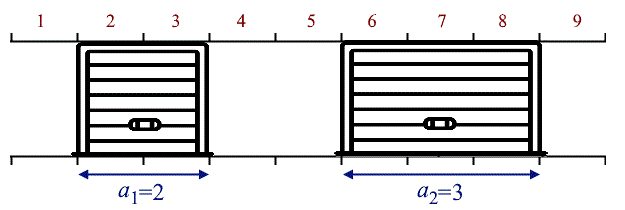306265: CF1170E. Sliding Doors
Description
Imagine that you are the CEO of a big old-fashioned company. Unlike any modern and progressive company (such as JetBrains), your company has a dress code. That's why you have already allocated a spacious room for your employees where they can change their clothes. Moreover, you've already purchased an $m$-compartment wardrobe, so the $i$-th employee can keep his/her belongings in the $i$-th cell (of course, all compartments have equal widths).
The issue has occurred: the wardrobe has sliding doors! More specifically, the wardrobe has $n$ doors (numbered from left to right) and the $j$-th door has width equal to $a_j$ wardrobe's cells. The wardrobe has single rails so that no two doors can slide past each other.
 Extremely schematic example of a wardrobe: $m=9$, $n=2$, $a_1=2$, $a_2=3$.
Extremely schematic example of a wardrobe: $m=9$, $n=2$, $a_1=2$, $a_2=3$. The problem is as follows: sometimes to open some cells you must close some other cells (since all doors are placed on the single track). For example, if you have a $4$-compartment wardrobe (i.e. $m=4$) with $n=2$ one-cell doors (i.e. $a_1=a_2=1$) and you need to open the $1$-st and the $3$-rd cells, you have to close the $2$-nd and the $4$-th cells.
As CEO, you have a complete schedule for the next $q$ days. Now you are wondering: is it possible that all employees who will come on the $k$-th day can access their cells simultaneously?
InputThe first line contains two integers $n$ and $m$ ($1 \le n \le 2 \cdot 10^5$, $1 \le m \le 4 \cdot 10^5$) — the number of doors and compartments respectively.
The second line contains $n$ integers $a_1, a_2, \dots, a_n$ ($1 \le a_i \le m$, $\sum{a_i} \le m$) — the corresponding widths of the doors.
The third line contains a single integer $q$ ($1 \le q \le 2 \cdot 10^5$) — the number of days you have to process.
The next $q$ lines describe schedule of each day. Each schedule is represented as an integer $c_k$ followed by $c_k$ integers $w_1, w_2, \dots, w_{c_k}$ ($1 \le c_k \le 2 \cdot 10^5$, $1 \le w_1 < w_2 < \dots < w_{c_k} \le m$) — the number of employees who will come on the $k$-th day, and their indices in ascending order.
It's guaranteed that $\sum{c_k}$ doesn't exceed $2 \cdot 10^5$.
OutputPrint $q$ answers. Each answer is "YES" or "NO" (case insensitive). Print "YES" if it is possible, that all employees on the corresponding day can access their compartments simultaneously.
ExampleInput3 10 2 3 2 6 1 5 2 1 10 2 2 9 2 5 6 3 1 7 8 4 1 2 3 4Output
YES YES NO NO YES NO